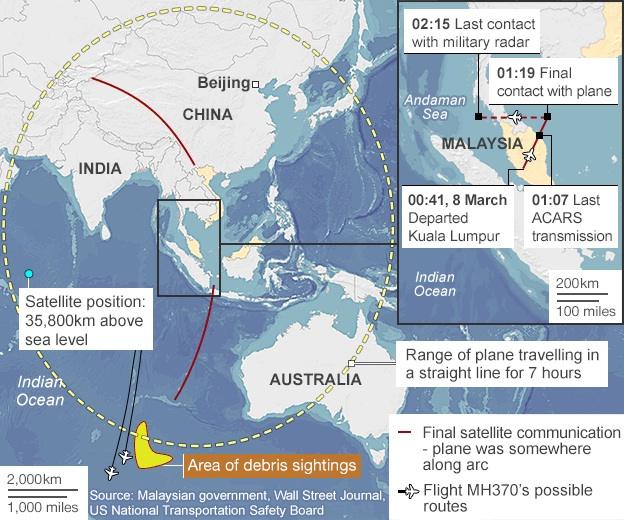A day with the MH370 search mission
- Published
The search teams look away from the ocean only occasionally to rest their eyes, as Jonathan Head reports
With its blunt, unswept lines and massive four-blade propellers, the P3 Orion is a throwback to a bygone era of aviation.
The plane I flew on from Pearce air base in Western Australia out into the southern Indian Ocean was delivered to the Royal New Zealand Air Force in 1966, making it considerably older than most of the crew.
But it is the ideal machine to meet the formidable challenge of searching for an airliner that may have gone down over some of the remotest seas on our planet.
The crew are a tight bunch, used to making long flights together over the Pacific within the narrow confines of the aircraft.
They are led by Squadron Leader Brett "Slim" McKenzie - a pilot with 25 years of experience, who flew Air New Zealand Boeing 747s for a while before coming back to the Orion - and Flight Lt Eric King, a British officer on secondment from the Royal Air Force, as the UK no longer has long-range maritime surveillance aircraft after the cancellation of the Nimrod project four years ago.
Skimming above
Based on the airframe of a mid-sized 1950s airliner, most of the P3's interior is taken up by a rack of large screens on which information from the plane's formidable arsenal sensors is displayed and analysed.
It has sophisticated surface radar, infra-red and high-definition cameras in a revolving turret, and what's known as the "stinger" - a fibreglass boom that protrudes from the tail which can detect submarines.

The plane takes four hours to reach the search area
Some of the crew sit in front of the screens for most of the 11-hour flight, recording and identifying anything of interest. Any large piece of wreckage could be easily tracked.
But they know that's unlikely in the 4,000 square km (1,544 square miles) patch of ocean they have been given to scan for this trip.
More likely is a sighting of floating objects - seat cushions for example - and for that there is no suitable technology. Only human eyesight.
The site we are heading to is 2,500 km (1,550 miles) south-west of Perth. It lies in the vast southern reaches of the Indian Ocean.
It takes our aircraft four hours to reach the site; it then has two to three hours to search, before it has to turn back - there is no land anywhere close should something go wrong.
When we reach the site, Squadron Leader McKenzie takes the P3 down sharply through the clouds, until the aircraft is skimming a little over 100 metres above the surface of the steel-grey sea.
Everyone dons lifejackets at this point, and we are shown how to pull on immersion suits - in case we end up in the sea. But the P3 is remarkably stable, flying like this for hours at low level.
Intense concentration
The crew then move to the large oval windows, keeping headsets on to communicate any sightings, and a marker pen to write down the bearing and distance of any object.
And they start to scan, moving their eyes back and forth methodically, trying to spot anything out of the ordinary amid the endless white-cap waves.
This is something they have done many times before, on search-and-rescue missions in the Pacific.
The P3 moves along a line for more than 200km, then turns, and comes back, a bit like a lawnmower.
Down in this remote spot, there isn't much to see. No ships, aside from a distant glimpse of the Norwegian car carrier that is helping with the search.
At one point we pass over a large pod of dolphins, diving through the waves.

The plane has been in service since 1966
There is an atmosphere of intense concentration, as the crew listen out for any news of debris. Every 30-45 minutes, those at the windows are replaced to give their eyes a break from the monotony of the sea racing past.
At one point the plane veers off to investigate a report of a large object outside our search area; it turns out to be a massive clump of seaweed.
The last task before turning back is to drop a buoy with a GPS attached - to give the search co-ordinators an idea of the currents in this little-known stretch of ocean.
Two crew members hooked to safety harnesses open the rear door. There's a rushing of cold air, and the buoys are thrown out.
Then, as the sun sets gloriously behind us, the old plane climbs steeply and sets a course for Perth.
Now the crew can relax. They tuck into microwaved meals - the New Zealanders have actually put an oven in the back of the aircraft to give themselves the option of a roast dinner, but they rarely have time to use it.
They find comfortable corners to lie down and read a book or newspaper, as Squadron Leader McKenzie guides them back to base.
There will be a debriefing after they land, and a short night's sleep, before they are back for the next mission the following day.
